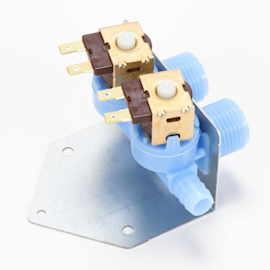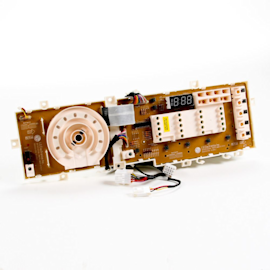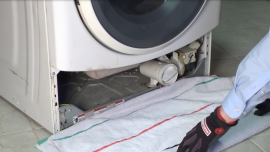- Kenmore refrigerator water filters
- Whirlpool refrigerator water filters
- Samsung refrigerator water filters
- GE refrigerator water filters
- LG refrigerator water filters
- Frigidaire refrigerator water filters
- KitchenAid refrigerator water filters
- Maytag refrigerator water filters
- Kenmore Elite refrigerator water filters
- Estate refrigerator water filters
- GE Profile refrigerator water filters
- Amana refrigerator water filters
- Bosch refrigerator water filters
- Dacor refrigerator water filters
- Electrolux refrigerator water filters
How to use your washing machine efficiently


Read the owner’s manual to familiarize yourself with the specific features and settings of your washer. Washing machines have various options and functions. Some settings are more energy efficient and use less water. Knowing the features of your washer will help you use it efficiently.
Follow these tips to use the washing machine efficiently so it lasts longer and you save money on utility bills.
Don’t overload the washer
When you pack your washer too full, clothes don’t have room to agitate. That can cause them to not get clean enough and water won’t spin out of the clothes fully. Wet clothes will take longer to dry in the dryer – wasting a significant amount of energy.
Overloading the washer will also strain components such as the drive motor, drive belt, bearings, seals, suspension springs, dampers and shocks. Worn components can cause the washer to use more energy. You’ll wind up spending money repairs or having to replace the washer more frequently when you overload it.
So, how full is too full? If you’re packing the clothes in tight, that’s your first clue that you’re overloading your washer.
One of the [benefits of a front load washer](https://www.searshomeservices.com/blog/benefits-of-a-front-load-washer) is higher load capacity but you can still overload this type of washing machine. Washers vary, so check your manual, but a good rule is to loosely load the clothes and leave at least 6 inches between the top of the load of laundry and the top of the drum.
Sort laundry properly
Sorting laundry properly can help your washer work more efficiently in several ways.
Different types of fabrics and garments require different wash cycles. By sorting your laundry, you can identify items that need delicate or gentle cycles which use less energy versus those that require more robust or heavy-duty cycles.
Sorting laundry allows you to separate clothes based on their recommended water temperature. Using the appropriate water temperature for each load is essential for efficient cleaning. For example, heavily soiled or stained items may require hot water, while delicate or color-sensitive garments benefit from cold water. By sorting your laundry, you can optimize the water temperature settings, which in turn helps your washer work more efficiently and reduces energy consumption.
Begin by sorting your laundry into separate piles based on color. Generally, you should separate whites, darks, and colors. This prevents colors from bleeding onto lighter items and keeps your clothes looking their best.
After sorting by color, you can further separate clothes based on the fabric type. This is particularly important when washing delicate or heavily soiled items. Separate delicate fabrics, such as silk, lace, satin, or items with beading or sequins. These items typically require gentle washing. Sort heavy fabrics like towels, bed sheets, and denim separately. You can use heavy-duty cycles to wash these items.
Select the right cycle settings
Now that you have laundry sorted, choose the appropriate cycle and temperature setting when loading each batch.
Water level
Many HE (high efficiency) washers automatically detect load size and choose the water level for you. As long as you avoid overloading the washer, the automatic water level will be sufficient for cleaning the clothes. To save energy, resist the temptation to use the Extra Fill or Deep Fill settings that use more water.
If you have a washer that lets you manually select water level, choose the right water level for the size of the batch you’re loading. You can save water by choosing lower water levels for lighter loads. Over time, you’ll save money on your water bill by selecting the right water level.
Cycle type
Choose the cycle appropriate for the batch of laundry that you’re washing. Don’t use the normal or heavy-duty cycle for every load. That will waste energy. Use the shorter delicate cycle to wash fragile garments. Choose the permanent press cycle when appropriate. Using the less-aggressive cycles when needed prevents unnecessary wear and tear on the machine and saves energy.
Water temperature
Select the cold water temperature setting whenever possible. Unless you have heavily soiled clothes that require hot water, cold water will clean clothes effectively. Using the cold water setting consistently will cut energy consumption of your washer in half.
Use a laundry detergent specifically designed for cold water to make sure clothes get clean.
In summary, making smart choices when selecting cycle settings can save water, energy and washing machine wear. You’ll also notice that clothes looks better and lasts longer.
Maintain your washer
With all of the filling, sloshing, draining and spinning it does, your washing machine needs regular cleaning and maintenance to keep it operating efficiently. Your washer will use less energy when you keep it in top shape with regular maintenance.
Clean the inside of the washer monthly
Use a washer cleaner such as Affresh or Washer Magic to clean the inside of your washing machine. The cleaner removes detergent residue that builds up inside the machine. Excessive detergent residue can cause oversudsing which will prevent the washer from draining and spinning water out of the clothes properly. The dryer will need to use more energy to dry wet clothes. Don’t neglect this important maintenance step to keep your washer working efficiently.
Clean the end of the washer drain hose
Pull the drain hose out of the stand pipe or drain sink and check for residue in the hose opening. Clear any lint or debris clogging the hose. Reinstall the hose in the stand pipe or drain sink.
Keeping the drain hose clear will make sure that the washer efficiently drains out water so clothes are dryer when you transfer them to the dryer. The dryer will use less energy to dry the clothes when you keep the drain hose clear.
Also, the drain pump will use less energy and last longer when you clean the drain hose regularly.
Schedule professional washer maintenance yearly
To keep your washing machine in top condition and operating efficiently, schedule professional Cleaning & Maintenance service every year.
During washer service, the Sears technician will:
Inspect water fill hoses. The technician will inspect fill hoses for cracks and wear that can indicate potential failure. The tech will recommend fill hose replacement when it’s likely that a fill hose is at the end of its useful life. This maintenance step will ensure that the washer fills to the properly level for efficient operation.
Check the washer tub and internal hoses for wear and leaks. During washer maintenance, the technician will check internal fill hoses, dispenser hoses and drain hoses for leaks and wear that need addressing. Making sure that detergent properly dispenses will help the washer work efficiently.
Test the washer drain system. The washer won’t clean and spin clothes if the drain system doesn’t fully remove water during the drain portion of the cycle. The technician will check drain pump operation and examine the complete drain path through your home’s drain system. The tech can clear obstructions and let you know if your house drain needs clearing. This will help the washer to get clothes as dry as possible before they go into the dryer so that you save energy when drying laundry.
Check water fill level and water temperature. To keep your washer working efficiently, the technician check water fill levels and the water temperature. The washing machine won’t clean the clothes well if water level is too low. Too much water can cause leaks and damage suspension components. If water temperature controls aren’t working properly, the washer can waste energy.
Check the suspension system and spin cycle operation. Excessive vibration or banging during the spin will often result in clothes being too wet when the cycle ends. The technician will test the spin cycle and make sure that suspension components such as shock absorbers and springs are intact and working properly. The tech also will check washer leveling and stability and adjust leveling legs as needed to minimize vibration during the spin cycle.
Run a cleaning cycle. The technician will typically run a cleaning cycle using a washer cleaner to remove deposits and detergent residue from the washer.
Bundle washing machine maintenance with clothes dryer maintenance service to save money and keep both laundry appliances working smoothly and saving energy.
By following these tips, you can use your washing machine efficiently, save energy and water, and prolong the lifespan of your clothes washer. You’ll also help the environment while lowering your utility bills.
Symptoms for front-load washers
Main causes: bad door lock assembly, wiring failure, bad electronic control board, drain system failure, bad water-level…
Main causes: leaky water supply hoses, clogged drain system, torn door boot, cracked outer tub, overfilling…
Main causes: garments left in the washer, damaged spin basket, worn outer tub bearing, faulty drive motor, bad electroni…
Repair guides for front-load washers

How to replace a water inlet valve on a front-load washer
The water valve assembly is the gatekeeper for water entering your front-load washer. You can replace it yourself, follo…
Repair difficulty
Time required
30 minutes or less

How to replace a motor control board on a front-load washer
The motor control board makes sure the motor spins in the right direction and at the right speed. You can install a new …
Repair difficulty
Time required
30 minutes or less

How to replace the user interface board in a front-load washer
Follow these steps to replace the user interface board in your front-load washer if the buttons or lights are broken.…
Repair difficulty
Time required
30 minutes or less
Articles and videos for front-load washers

Find tips for using your washing machine efficiently to save energy and help reduce utility bills.…

Learn about all the convenient features on our Sears PartsDirect website that make your parts purchases easier.…

See how to access and clean the drain pump filter on a front-load washer without an access door.…